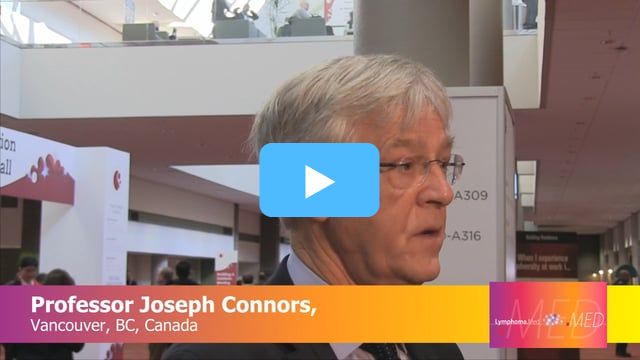Advertisment
ASH 2017: ECHELON-1: Brentuximab vedotin plus AVD in HL produces PFS improvement

Article written by Tom Collins. Interviews by Esther Drain.
Replacing bleomycin with brentuximab vedotin (A+AVD) in the traditional regimen for previously untreated Hodgkin lymphoma patients significantly improved modified progression-free survival (PFS) — by about 5% at 2 years — compared to the ABVD arm (doxorubicin, bleomycin, vinblastine, dacarbazine).
Replacing bleomycin with brentuximab vedotin (A+AVD) in the traditional regimen for previously untreated Hodgkin lymphoma patients significantly improved modified progression-free survival (PFS) — by about 5% at 2 years — compared to the ABVD arm (doxorubicin, bleomycin, vinblastine, dacarbazine).
The primary endpoint of modified PFS included disease progression, death, or a “non-complete response” after therapy as determined by an independent committee and followed by subsequent therapy.
About 20 more patients had survived at 2 years in the A+AVD arm, but the overall survival difference was not statistically significant (p=0.19) as the data needs to mature.
Presenters said the findings represent an important advance in the treatment of HL, particularly because — with the elimination of bleomycin — pulmonary toxicities were reduced. Also presented was data showing that this is the first time that a head-to-head with ABVD in frontline HL has demonstrated superiority for an alternative regimen, despite being used for four decades.
In the open-label trial, known as ECHELON-1, a total of 1,334 patients were randomized across 21 countries either to A+AVD or ABVD.
More patients in the ABVD arm required at least one subsequent chemotherapy for their HL — 99 compared to 66.
Professor Joseph Connors, MD, clinical director of the Centre for Lymphoid Cancer at the British Columbia Cancer Agency, who presented the findings, emphasized the importance of that difference.
“What we’re trying to do in this situation is to avoid the necessity for those secondary treatments to be used,” he said.
Because febrile neutropenia and peripheral neuropathy decreased in the trial once the principal investigators began to strongly recommend the use of prophylactic growth factors, investigators have said that this preventive treatment is essentially mandatory with the use of A+AVD, Professor Connors said.
The findings have just been published in the New England Journal of Medicine, and two independent editorialists in NEJM wrote that it’s “too early to rule out unanticipated side effects” of A+AVD but that the regimen “merits consideration” as a first-line treatment in HL.
After his oral presentation at ASH, Prof. Connors was asked about whether the large price difference between A+AVD and ABVD made the new regimen worth it.
“A careful pharmaco-economic analysis should be conducted,” Prof. Connors said, but said he would leave such an analysis to the experts.
Professor Nancy Bartlett, MD, professor of oncology at Washington University in St. Louis, hit on some notes of caution about the A+AVD regimen.
The pulmonary toxicity concern that the elimination of bleomycin alleviates, she said, may become less of an issue as time goes by.
“Now we know in patients who have an interim negative PET, that you can eliminate bleomycin from the last 4 cycles of ABVD,” she said. “So, we’re likely to see a lot less pulmonary toxicity than we have in the past.”
She said that while ECHELON-1 was a positive trial, “I think a lot of us in the field were a little disappointed that the difference is smaller than we had hoped.”
She said we “need” the overall survival curves to diverge, since now they’re statistically the same.
Professor Connors concluded that “this is a definition of a new frontline treatment that appears to have greater effectiveness than the one that is most commonly used around the world. If adopted, we would expect to see the increase in the likelihood of curing patients with the first round of treatment.
About one quarter of the patients who wouldn’t have been cured by the standard treatment were cured by the new treatment” A+AVD.
References
Connors J, Jurczak W, Straus D, et al. Brentuximab Vedotin with Chemotherapy for Stage III or IV Hodgkin’s Lymphoma. N Engl J Med. 10 Dec 2017. Online ahead of print.
Longo D, DeVita. Progress in the Treatment of Hodgkin’s Lymphoma. N Engl J Med. 10 Dec 2017. Online ahead of print.





